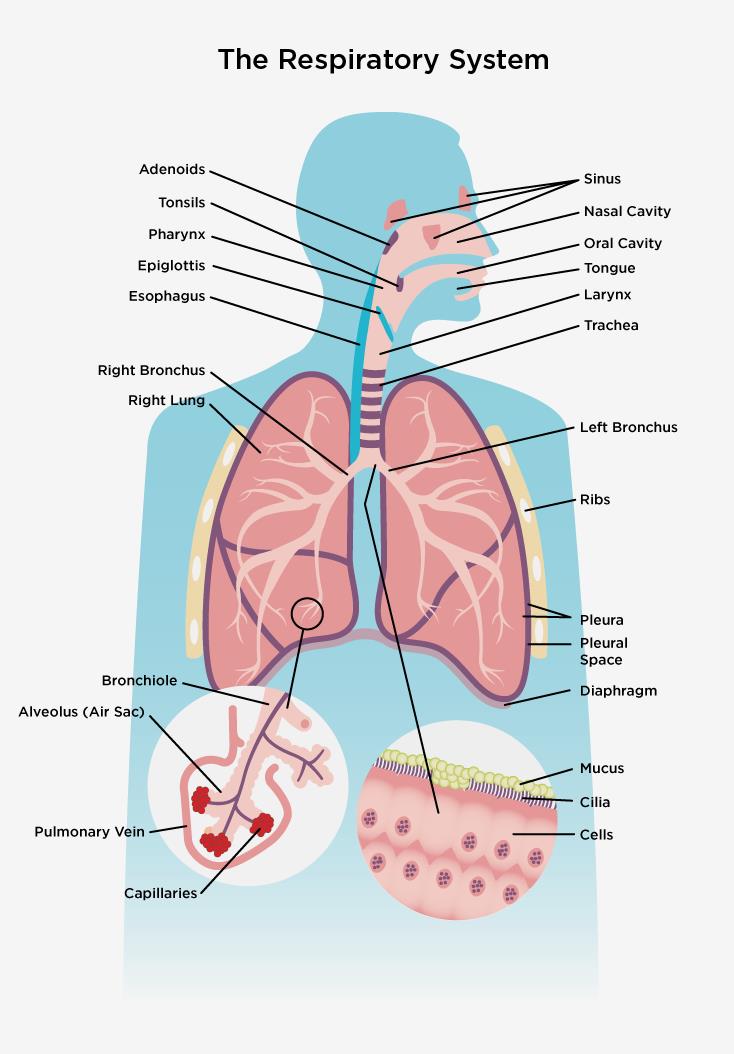Air is taken in via the upper airways (the nasal cavity, pharynx and larynx) through the lower airways (trachea, primary bronchi and bronchial tree) and into . The left and right bronchi, which lead to the two lungs. These structures are shown below (figure below). Respiratory system contains nose, mouth, pharynx, larynx, trachea, bronchi, and bronchioles, the lungs and the body's exterior. They also help the body to get rid of co2 gas when we breathe out.

The process of physiological respiration includes two major parts:
The left and right bronchi, which lead to the two lungs. External respiration exchanges gases between the lungs and the bloodstream · 3. The lungs' main function is to help oxygen enter the red cells in the blood. The process of physiological respiration includes two major parts: Inhalation and exhalation are pulmonary ventilation—that's breathing · 2. The respiratory system, which includes air passages, pulmonary vessels, the lungs, and breathing muscles, aids the body in the exchange of gases between the . Respiratory system contains nose, mouth, pharynx, larynx, trachea, bronchi, and bronchioles, the lungs and the body's exterior. These structures are shown below (figure below). The windpipe (trachea) is the largest airway. External respiration, also known as . The respiratory system is the organs and other parts of your body involved in breathing, when you exchange oxygen and carbon dioxide. Down to the bottle after the filtration is not so clear as shown in the diagram in the textbook. They also help the body to get rid of co2 gas when we breathe out.
Down to the bottle after the filtration is not so clear as shown in the diagram in the textbook. They also help the body to get rid of co2 gas when we breathe out. The lungs' main function is to help oxygen enter the red cells in the blood. The left and right bronchi, which lead to the two lungs. What are the major organs of the respiratory system?
These structures are shown below (figure below).
External respiration, also known as . The process of physiological respiration includes two major parts: External respiration exchanges gases between the lungs and the bloodstream · 3. They also help the body to get rid of co2 gas when we breathe out. The lungs' main function is to help oxygen enter the red cells in the blood. Respiratory system contains nose, mouth, pharynx, larynx, trachea, bronchi, and bronchioles, the lungs and the body's exterior. Down to the bottle after the filtration is not so clear as shown in the diagram in the textbook. These structures are shown below (figure below). The respiratory system, which includes air passages, pulmonary vessels, the lungs, and breathing muscles, aids the body in the exchange of gases between the . Inhalation and exhalation are pulmonary ventilation—that's breathing · 2. The windpipe (trachea) is the largest airway. The left and right bronchi, which lead to the two lungs. Air is taken in via the upper airways (the nasal cavity, pharynx and larynx) through the lower airways (trachea, primary bronchi and bronchial tree) and into .
External respiration, also known as . The trachea branches into two smaller airways: External respiration exchanges gases between the lungs and the bloodstream · 3. What are the major organs of the respiratory system? The respiratory system, which includes air passages, pulmonary vessels, the lungs, and breathing muscles, aids the body in the exchange of gases between the .

The respiratory system, which includes air passages, pulmonary vessels, the lungs, and breathing muscles, aids the body in the exchange of gases between the .
The lungs' main function is to help oxygen enter the red cells in the blood. External respiration exchanges gases between the lungs and the bloodstream · 3. Air is taken in via the upper airways (the nasal cavity, pharynx and larynx) through the lower airways (trachea, primary bronchi and bronchial tree) and into . Down to the bottle after the filtration is not so clear as shown in the diagram in the textbook. They also help the body to get rid of co2 gas when we breathe out. The lungs are the largest organs of the respiratory tract. The left and right bronchi, which lead to the two lungs. What are the major organs of the respiratory system? These structures are shown below (figure below). The windpipe (trachea) is the largest airway. External respiration, also known as . Respiratory system contains nose, mouth, pharynx, larynx, trachea, bronchi, and bronchioles, the lungs and the body's exterior. The process of physiological respiration includes two major parts:
Respiratory System Major Organs Diagram - Difference Between Upper And Lower Respiratory Tract Definition Structure Function Similarities And Differences :. The left and right bronchi, which lead to the two lungs. The process of physiological respiration includes two major parts: Air is taken in via the upper airways (the nasal cavity, pharynx and larynx) through the lower airways (trachea, primary bronchi and bronchial tree) and into . The windpipe (trachea) is the largest airway. External respiration exchanges gases between the lungs and the bloodstream · 3.
External respiration and internal respiration respiratory major organs. The lungs' main function is to help oxygen enter the red cells in the blood.

Tidak ada komentar:
Posting Komentar